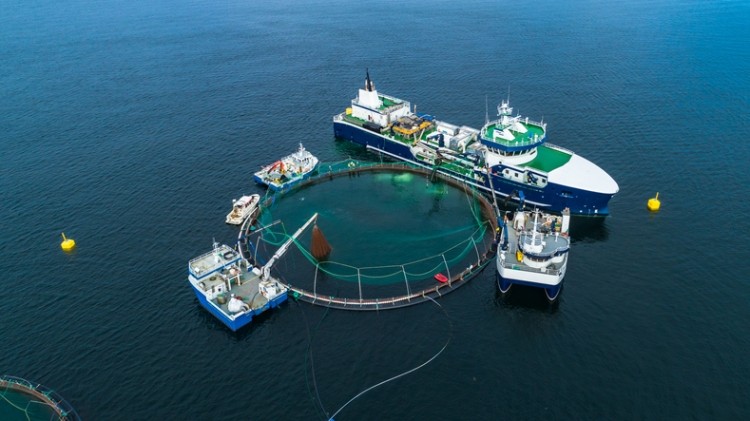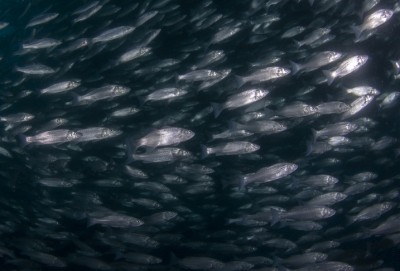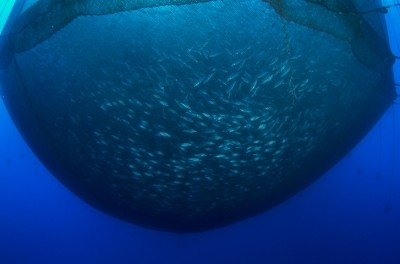Challenges replacing fishmeal in certain farmed fish diets

As part of the process toward commercialization of Totoaba macdonaldi, researchers with several academic institutions in Mexico and Chile examined how much soybean meal (SBM) could be used in the diets to replace fishmeal (FM) without provoking negative responses in fish health. The group published its work in the journal Aquaculture.
“As SBM is a lower-cost protein alternative to FM, in the present work we evaluate the effect of graded levels of SBM on growth performance, digestive capacity, molecular expression, distal intestine and liver integrity in juveniles of Totoaba macdonaldi, that may result in enteritis with detrimental outcomes in fish of commercial size,” they said.
The research team found that severe enteritis symptoms in the distal intestine and liver were produced when soybean meal (SBM) was included in amounts higher than 22% of the diet. There also was some evidence of impaired immunological response when much higher levels – 44% and 64% – were used.
“Results indicate a detrimental status of the digestive physiology of totoaba fed SBM-based diets at inclusion levels above 22%,” said the researchers. “Thus, suggesting that SBM should be cautiously used in totoaba feed formulations.”
Why swap fishmeal for soybean meal?
Replacing fishmeal (FM) in aquaculture has been a focus of feed research and several vegetable sources like soybean meal have been considered, the researchers said. SBM provides the most protein among plant-based ingredients and is considered a promising alternative protein.
For the industry, defatted-SBM is considered an alternative that can replace at least part of the FM used in marine fish feeds as it is inexpensive, provides 40-48% crude protein and has a consistent amino acid profile, they said.
However, it also has been linked to the occurrence of enteritis – the non-infectious inflammation of the distal intestine – in some carnivorous fish, they said. SBM also includes an amount of anti-nutritional factors for fish like protease inhibitors, saponins, phytic acid, lectins, antigens, alkaloids, oligosaccharides and glucosinolates, which are associated with health challenges including damage to mucosal integrity, a reduction in pancreatic and brush-border enzymes, lower mineral absorption and immune suppression.
Little is known about the use of soy feed ingredients in the diets of Totoaba macdonaldi, they said. But the marine carnivorous species is considered to have high potential for use in commercial aquaculture.
Previous work with the species reported that adding soybean protein concentrate (SPC) improved growth, feed efficiency and maintained acceptable hematological parameters for fish fed a diet with 30 to 60% SPC, said the researchers. However, some hepatic damage also has been reported in fish given SPC-diets.
It has been suggested that when taurine is supplemented at 1% and fish are given an SPC-based diet enteritis damage was not found, they said. And a previous study reported that using up to 34% SPC in a diet with 1.5% taurine did not alter fish growth.
However, no published data exist regarding a complete evaluation of fish performance, digestive physiology and immunological response, they said.
Methods and materials
In the feeding trial, four diets were given to 48 fish for eight weeks, the researchers said.
The diets were designed to replace FM protein at 0, 25, 50 and 75% with a mix of SPC and SBM at a 1:4 ratio and all diets included krill oil and 1 g kg-1 taurine, they said. The SBM used included 48% crude protein and the SPC was 60% protein.
“Four essential amino acids (lysine, methionine, threonine and arginine) were supplemented to reach equal levels found in the control diet (0% SBM),” they said. “Although dietary treatments were formulated to replace FM protein at 0, 25, 50 and 75% with a mix of soybean meals, the actual SBM mixture content for each treatment was 0, 22, 44 and 64%.”
Feed consumption was tracked during the trial and fish were measured and weighed at the outset and then every 15 days, said the researchers. The thermal growth coefficient (TGC), feed conversion ratio (FCR), condition factor (CF), protein efficiency ratio (PER), feed intake, Hepatosomatic Index (HSI), Viscerosomatic Index (VSI) and intestinal somatic index (ISI) were all calculated.
Fish were sampled for analysis on weeks four and eight, they said. And samples of digestive enzyme activity were collected at the end of the feeding trial.
Results
Overall, the feeding trial found that there were some limitations to the use of soybean meal in the diets of T. macdonadli, the researchers said. The feed ingredient appears to alter the structure and physiology of the distal intestine and digestive enzyme activity when included at intermediate or higher levels.
“Our findings demonstrated a state of intestinal atrophy in totoaba caused by the exposure of high dietary SBM inclusion levels during the time,” they said. “Therefore, the present work directly suggests that SBM should be cautiously used in totoaba feeds.”
Growth at the end of the feeding trial was altered by diet, they said. Fish on the control diet outperformed those on the trial diets.
The increasing level of SBM affected TGC, FCR, CF, PER and HSI, they said. Fish getting the diet with 64% SBM had reduced growth, higher FCR and worse condition factor scores compared to the control.
Similarly, fish on the control diet demonstrated no signs of morphological damage at week four or eight, the researchers said. Fish getting SBM demonstrated mucosal inflammation and intestinal damage, which increased linearly depending on the level of the alternative protein in the feed.
As the amount of SBM increased, the amount of mucosal fold (MF) atrophy also grew, they said. Dietary SBM also was found to support the development of lipid vacuoles in pancreatic tissue.
The activity of several proteases and amylase in the intestine declined as levels of SBM were increased in the diet, they said. “Although, l-aminopeptidase did not result in significant differences in total activity among treatments, a considerable decrease in intestinal activity was observed in the 44% and 64% SBM inclusion levels,” they added.
In terms of gene expression, at four weeks there was an increase in the expression of interleukin for fish getting the diet with 22% SBM, however, results for the control and other trial diets were the same, they said. All diets had similar results at week eight.
Source: Aquaculture
Title: Enteritis induction by soybean meal in Totoaba macdonaldi diets: Effects on growth performance, digestive capacity, immune response and distal intestine integrity
Authors: J Fuentes-Quesada, M Viana, A Rombenso, Y Guerrero-Rentería, M Nomura-Solís, V Gomez-Calle, J Lazoa, J Mata-Sotres
DOI: doi.org/10.1016/j.aquaculture.2018.05.025












